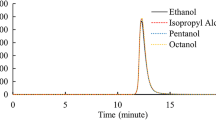Abstract
Purpose. Protein stabilization during lyophilization has previously focused on optimization of the formulation as well as the freezing and dehydration process parameters. However, the effect of the reconstitution medium has been largely neglected. We have investigated its effect on aggregate formation using recombinant keratinocyte growth factor (KGF).
Methods. The protein was lyophilized under suboptimal conditions to induce aggregation and precipitation upon reconstitution with water. A series of additives were examined by UV spectrophotometry and size exclusion chromatography (SEC-HPLC) for their effects on decreasing the degree of KGF aggregation and precipitation by the increase in recovery of soluble monomer.
Results. Several additives resulted in a significant reduction of aggregation, including sulfated polysaccharides, surfactants, polyphosphates, and amino acids. A similar effect was achieved by adjusting the ionic strength of the reconstitution medium. SEC-HPLC indicated that the amount of soluble monomer was also increased by these additives suggesting that the recovery of the soluble protein correlates with the native, monomeric protein.
Conclusions. These results suggest that optimization of reconstitution conditions will be a useful methodology for increasing the recovery of soluble, active proteins and that for KGF, the recovery of the soluble protein correlates with the native, monomeric form.
Similar content being viewed by others
REFERENCES
C. Manning, K. Patel, and R. T. Borchardt. Stability of protein pharmaceuticals. Pharm. Res. 6:903–918 (1989).
M. J. Pikal. Freeze-drying of proteins. II. Formulation selection. BioPharm. 3:26–30 (1990).
T. Arakawa, J. F. Carpenter, Y. A. Kita, and J. H. Crowe. Basis for toxicity of certain cryoprotectants. A hypothesis. Cryobiology 27:401–415 (1990).
J. F. Carpenter and J. H. Crowe. An infrared spectroscopic study of interactions of carbohydrates with dried proteins. Biochemistry 28:3916–3922 (1988).
T. Chen. Formulation concerns of protein drugs. Drug Dev. Ind. Pharm. 18:1311–1354 (1992).
A. Rupley, E. Gratton, and G. Careri. Water and globular proteins. Trends Biochem. Sci. 8:18–22 (1983).
T. Tagaki. Application of low-angle laser light scattering detection in the field of biochemistry. J. Chromatorgr. 506:409–416 (1990).
J. S. Rubin, H. Osada, P. W. Finch, W. G. Taylor, S. Rudickoff, and S. A. Aaronson. Purification and characterization of a newly identification growth factor specific for epithelia cells. Pro. Natl. Acad. Sci. USA 86:802–806 (1988).
P. W. Finch, J. S. Rubin, T. Miki, D. Ron, and S. A. Aaronson. Human KGF is FGF-related with properties of a paracrine effector of epithelial cells. Science 245:752–755 (1989).
S. A. Aaronson, J. S. Rubin, P. W. Finch, J. Wong, C. Marchese, J. Falco, W. G. Taylor, and M. H. Kraus. Growth factor-regulated pathways in epithelial cell proliferation. Am. Rev. Respir. Dis. 142:S7–S10 (1990).
B. L. Chen, T. Arakawa, C. F. Morris, W. C. Kenney, C. M. Wells, and C. G. Pitt. Aggregation pathway of recombinant human keratinocyte growth factor and its stabilization. Pharm. Res. 11:1582–1589 (1994).
K. Tsai, D. B. Volkin, J. M. Dabora, K. C. Thompson, M. W. Bruner, J. O. Gress, B. Matuszewska, M. Keogan, J. V. Bondi, and C. R. Middaugh. Formulation design of acidic fibroblast growth factor. Pharm. Res. 10:649–659 (1993).
D. Ron, D. P. Bottaro, P. W. Finch, D. Morris, J. S. Rubin, and S. A. Aaronson. Expression of biological active recombinant keratinocyte growth factor. J. Biol. Chem. 268:2984–2988 (1993).
J. H. Crowe, L. M. Crowe, J. F. Carpenter, and C. A. Wistrom. Stabilization of dry phopholipid bilayers and proteins by sugars. Biochem. J. 242:1–10 (1987).
M. J. Pikal, K. M. Dellerman, M. L. Roy, and R. M. Riggin. The effects of formulation variables on the stability of freeze dried human growth hormone. Pharm Res. 8:427–436 (1991).
T. Tamiya, N. Okahashi, R. Sakuma, T. Aoyama, T. Akahane, and J. J. Matsumoto. Freeze denaturation of enzymes and its prevention with additives. Cryobiology. 22:446–456 (1985).
S. Yoshioka, Y. Aso, K. Izutsu, and T. Terao. Aggregates formed during storage of β-galactosidase in solution and in the freeze-dried state. Pharm. Res. 10:687–691 (1993).
Author information
Authors and Affiliations
Rights and permissions
About this article
Cite this article
Zhang, M.Z., Wen, J., Arakawa, T. et al. A New Strategy for Enhancing the Stability of Lyophilized Protein: The Effect of the Reconstitution Medium on Keratinocyte Growth Factor. Pharm Res 12, 1447–1452 (1995). https://doi.org/10.1023/A:1016219000963
Issue Date:
DOI: https://doi.org/10.1023/A:1016219000963




